

Testing Your Business Model. La source du dilemme de l’innovateur ou la tragédie du modèle d’affaire: 1 – La rupture de nouveaux marché. Rethinking Business Model design // Rethinking Business Models for Innovation. Lienzo. Business Model Fiddle. Online Information Sharing Research More and more people use online tools to share information.
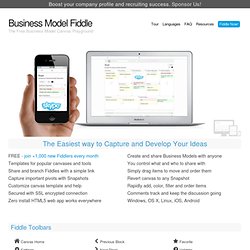
However there is a significant lack of knowledge concerning the social dynamics of these tools. The Vienna University of Economics and Business has contributed valuable knowledge on User Generated Content. Now, with the help of BMFiddle, they are researching Online Information Sharing. As a member of the BMFiddle community your response is essential to this effort plus it will help us to improve BMFiddle. It takes 10-15 minutes to complete the survey and responses are anonymous. Launch the survey! News and Reviews Social Enterprise Patterns. Alexander Osterwalder, Author - Steve Blank, Serial Entrepreneur - Tools for Business Model Generation. Achieve Product-Market Fit with our Brand-New Value Proposition Designer Canvas. I’m a big fan of the Lean Startup movement and love the underlying principle of testing, learning, and pivoting by experimenting with the most basic product prototypes imaginable - so-called Minimal Viable Products (MVP) – during the search for product-market fit.

It helps companies avoid building stuff that customers don’t want. Yet, there is no underlying conceptual tool that accompanies this process. There is no practical tool that helps business people map, think through, discuss, test, and pivot their company’s value proposition in relationship to their customers’ needs. So I came up with the Value Proposition Designer Canvas together with Yves Pigneur and Alan Smith. Resources from Around the Web. Two Aspects to Business Model Innovation. Business-unit Organization A very basic value chain for M2M and connected device applications involves these entities:connectivity providers (typically mobile operators and specialist M2M service providers),companies that are embedding connectivity in their devices and services (e.g. an eReader provider or a remote health monitoring service provider),and, the end user (either an enterprise or an individual consumer).
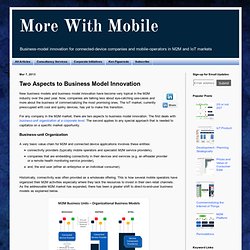
Historically, connectivity was often provided as a wholesale offering. This is how several mobile operators have organized their M2M activities especially where they lack the resources to invest in their own retail channels. Business model. Rotman Design Challenge 2013 - Keynote by Roger Martin.
Alexander Osterwalder: Mapping Customer Pains to Value Proposition with Steve Blank. (video via Standford University) Get the (FREE) Business Model Studio Resource Guide Continue and watch Alex use visual facilitation in front of a live audience.
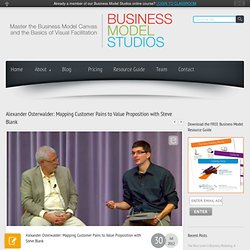
Please enter a valid email ABOVE: Click the play button and watch the video to see Alex in action! The effective FORTH innovation method. Revenue Model Types: The Quick Guide. A revenue model describes how a business generates revenue streams from its products and services.
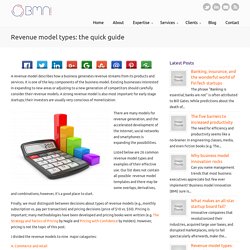
It is one of the key components of the business model. Existing businesses interested in expanding to new areas or adjusting to a new generation of competitors should carefully consider their revenue models. A strong revenue model is also most important for early stage startups; their investors are usually very conscious of monetization. There are many models for revenue generation, and the accelerated development of the Internet, social networks and smartphones is expanding the possibilities. Business Strategy Tools and Techniques from MindTools. Pourquoi les entreprises vont devoir multiplier les business model. Low cost ou haut de gamme ?
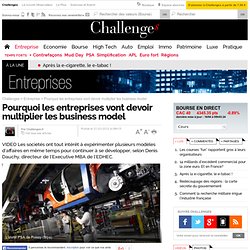
Les modèles économiques / La construction d’un modèle d’affaires. Le modèle d’affaires d’une société présente la répartition de l’activité et, notamment, l'origine de ses revenus afin de dégager de la rentabilité.
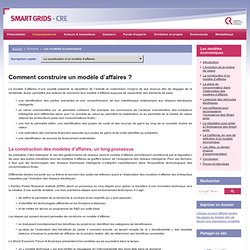
Aussi, permettre aux acteurs de concevoir leur modèle d’affaires suppose de rassembler des éléments de base : une identification des parties prenantes et une compréhension de leur intérêt/risque relativement aux réseaux électriques intelligents ;un calcul coût-bénéfice sur un périmètre cohérent. Business Model Innovation as R&D. Prior to my last post on music as an experience, I was in the middle of a series of posts exploring business model innovation for the enterprise.

A recent exchange on a LinkedIn discussion group has inspired me to pick that back up. In particular, I’d like to explore how a company should go about setting up a minimum viable business to continue the learning process that begins, really, with prototyping. (Authors note: These business model innovation “articles” are rather long and involved because I myself am trying to work through all the complexity. More like poorly edited papers than blog entries. Proceed at your own risk.) One of the defining characteristics of a start-up is the ratio of assumption-to-knowledge under which it operates. To get to that inflection point, the analog of R&D investing offers a lot. The power and elegance of the scientific method is in its recursive empirical investigation that always allows for falsifiability. Dependent variable “y” = people reading my blog.
Business Planning using Business Model Generation. Innovation de business model en PACA. Eight Models of Business Models, & Why They’re Important. The term Business Model is one that gets thrown around a lot these days.

Even though it might sound like a buzzword to you, it’s important to understand what a business model is, and how they are useful. One of the confusing things about the business model concept is that there are a wide variety of models of business models, and it seems as though everyone that talks about them makes up a new one. This can be frustrating if you are trying to figure out how to use the concept. At their core, all business models address this questions: how do we sustainably deliver value to our customers? In this instance, the sustainable part refers to your organisation – how can you deliver value so that you’re still around in the future?
In a special issue of the journal Long Range Planning, Charles Baden-Fuller and Mary Morgan say that business models can serve three different purposes. Value Networks from Verna Allee: Verna was working with some of the basic concepts of business models in the 90s. ER - EXPLORER. Elton-Pickford Europe. Business Models & Business-IT research.
As ‘value’ is one of the most common term in business model definitions, the obvious question is what is meant with value?
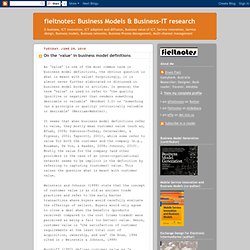
Surprisingly, it is almost never further elaborated or discussed in business model books or articles. In general the term ‘value’ is used to refer to ‘the quality (positive or negative) that renders something desirable or valuable’ (Wordnet 3.0) or ‘something (as a principle or quality) intrinsically valuable or desirable’ (Merriam-Webster). It seems that when business model definitions refer to value, they mostly mean customer value (such as, Afuah, 2004; Dubosson-Torbay, Osterwalder, & Pigneur, 2002; Tapscott, 2001), while some refer to value for both the customer and the company (e.g., Bouwman, De Vos, & Haaker, 2008; Johnson, 2010).
Mostly the value for the company (and other providers in the case of an inter-organizational network) seems to be implicit in the definition by referring to capturing (customer) value. Afuah, A. (2004).
Business Model. Business ecosystem - James F. Moore. A business ecosystem describes the structure and behaviour of a network of high-tech organisations that share a key technological platform and the ways individual firms can flourish in such an environment. Dr. James F. Moore was a Senior Fellow at Harvard Law School's Berkman Center for Internet and Society where he founded the Open Economies Project.
He studied change in large scale social, economic, and technical systems and is the pioneer and originator of biological metaphors of organisation behaviour such as “business ecosystems”, “Internet ecosystems” and the ecological approach to alliances and alliance-based competition. His research is primarily based on case studies in the high technology sector where the PC and Internet technologies favoured network based competition. The essence of a business ecosystem is that networks between companies need to be analysed from a higher conceptual level rather than from the viewpoint of individual organisations.